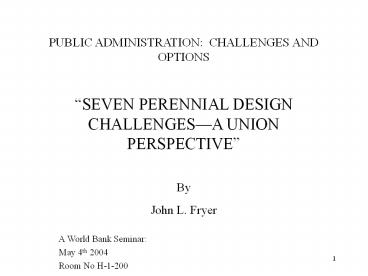PUBLIC ADMINISTRATION: CHALLENGES AND OPTIONS - PowerPoint PPT Presentation
1 / 12
Title:
PUBLIC ADMINISTRATION: CHALLENGES AND OPTIONS
Description:
public administration: challenges and options seven perennial design challenges a union perspective by john l. fryer a world bank seminar: – PowerPoint PPT presentation
Number of Views:101
Avg rating:3.0/5.0
Title: PUBLIC ADMINISTRATION: CHALLENGES AND OPTIONS
1
PUBLIC ADMINISTRATION CHALLENGES AND OPTIONS
- SEVEN PERENNIAL DESIGN CHALLENGESA UNION
PERSPECTIVE - By
- John L. Fryer
- A World Bank Seminar
- May 4th 2004
- Room No H-1-200
2
A Public Sector Union View of Consultations with
the World Bank
- You indict us in our absence
- You try us in our absence
- You convict us in our absence
- And then invite us to consult on the method of
our execution. - Larry Brown, Secretary Treasurer
- National Union of Public General Employees
(NUPGE-Canada)
3
Introduction
- Sincere thanks to Gary Reid for invitation.
- Delighted to learnlast Thursday, April 29th,
during PREM Learning Weekfrom PREM VP Gobind
Nankani as well as VP for Human Development
Jean-Louis Sarbib that World Bank believes in
and supports real consultations with unions. - Also happy to hear on April 30th from PREM Public
Sector Governance Director Sanjay Pradhan that
his department strongly supports the bottom up
approach to consultations with public sector
unions. - So it is clear that all of you can help greatly
in making these wishes a reality at the country
level. - Therefore my purpose today is to identify
approaches to public employee consultation
designed to maximize positive outcomes.
4
SEVEN PERENNIAL DESIGN CHALLENGES
- Pleased to accept Gary Reids Seven Point
template. - Reference introductory paper and indicate general
agreement that any nation and their people are
generally well served by an efficient and
effective public service. - Might not share ideological imperative that
small is always beautiful.
5
DESIGN CHALLENGE 1BIG BANG VERSUS INSTITUIONAL
REFORMS
- Preference for institutional reform with clear
goals and targets. - Need to understand union viewpoint that loss of a
job is equal to economic capital punishment. - Generally means death sentence to workers future
standard of living as well as that of family
members. - Must, therefore, expect resistance.
6
DESIGN CHALLENGE 2ENSURING ADEQUATE PLANNING OF
REFORM EFFORT
- Agree and urge very early involvement of
unions/associations representing workers likely
to be affected. - Appoint member of country team to have specific
responsibility for union consultation and
liaison. - Creative consultative mechanism with maximum
union input (i.e. joint chairs). - Consider assistance to unions to build
capacitydesigned to improve capacity of unions
to engage meaningfully. - Use facilities of WBI to plan such training at
country level.
7
DESIGN CHALLENGE 3ADDRESSING SOURCES OF
RESISTANCE
- Expect union push back.
- Engage unions, from outset, in design and purpose
of downsizing plans. - Consider carefully union input with regard to
design of implementation program and timetable. - Be sure to keep all workers aware of plans and
their time frame.
8
DESIGN CHALLENGE 4SEQUENCING
- Ensure that any salary adjustments (not just
major) follow completion of all other steps in
adjustment program(s).
9
DESIGN CHALLENGE 5TARGETING
REDUCTIONSHIGHLIGHT RATIONALE FOR EACH OPTION,
KEY CHALLENGES OF EACH OPTION AND DEVICES FOR
ADDRESSING THESE CHALLENGES
- Involve unions and members in design,
prioritization as well as implementation. - Emphasize voluntary attrition.
- Ensure fairness (across the board?).
- Make every effort to minimize pain involved in
programs of right sizing.
10
DESIGN CHALLENGE 6FACILITATING RE-ENTRY INTO
LABOR FORCE FOR DISMISSED EMPLOYEES
- Fully involve unions and members in design of
both assistance and re-entry assistance programs - Learn from extensive previous experience (i.e.
Armour Automation CommitteeGeorge Schultz) - Programs tailor made to individual assistance
strategies known to work best.
11
DESIGN CHALLENGE 7MAKING SEVERANCE PAY PROGRAMS
EFFECTIVE
- Determine severance budget in advance.
- Be prepared to allow maximum union involvement in
design and implementation of severance programs. - Resist desire to object to seniority and/or
family obligations in design. - Be willing to allow union to administer severance
programs and thus allow unions to accept
criticism and handle complaints from individual
employees.
12
IN SUMMARY
- Be sure to let union leaders know, at the outset,
that the World Bank welcomes their input. - Begin consultative process at earliest
opportunity. - Encourage bottom up involvement by unions
representing affected employees. - Ensure client governments understand that union
involvement will be part of the process. - Anticipate and accept that there will be
resistance to retrenchment by unions - Be, at all times, open to their input and let
them know that if they have a better idea, you
will work for its acceptance. - Be sure that unions receive positive
reinforcement for constructive contributions to
the overall program.































